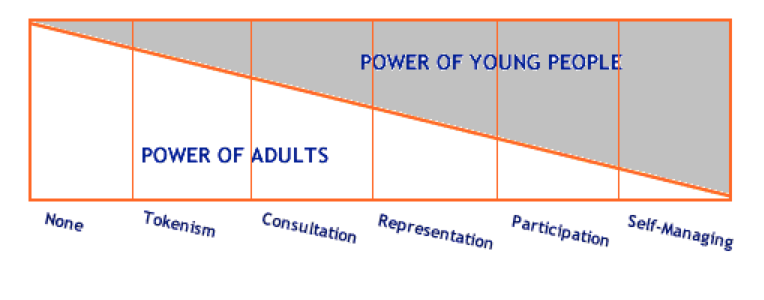Many years ago as a youth worker running health programs with teens, I was shown a chart that showed the balance of power between youth and adults as young people take on more meaningful and complete responsibility for programs. (I wish I knew where it came from). The loss of adult power helps to explain how hesitant adults can be about involving young people in decision-making. But the graphic isn’t all about loss. It also shows the power of young people increasing, which is something that youth workers strive for. Along with responsibility comes power and with power comes credit. The process of sharing power and sharing credit is never easy, but for each project there’s one spot along that continuum of youth engagement that feels like the right one to aim for. But how do we figure out where it is?
Recently I’ve been struggling with the same sort of question about community art. The community should be engaged and the community should have a voice. In fact, one of the main goals of most community art projects is to build community power, but if the community leads the project and designs the art, what’s the role of the “artist” on the project? And who’s failure is it if the final product is not beautiful? Who feels pride and who feels responsibility? Is the artist there as a facilitator? Is the artist there to provide guidance? Is the final product part of the artist’s portfolio? Is it fair to judge the artist on the community’s work and is it fair to allow the artist to claim credit for the community’s work?
If we replace youth with community in the graphic above, then somewhere along the continuum is the sweet spot for community involvement and the balance of power in each project. Perhaps it needs to be clearly articulated at the beginning so that no one is surprised by the limits of their own power, and so that the artist has the space to develop designs that he or she can be proud of once they’re compete. There are always constraints that limit the quality or the size of the output (time, manpower, money) but these can be managed by the artist and the community together.
As far as sharing ownership, I recently gathered stories from regional prevention coalitions and one of the things that I heard was that cities collaborating across borders are concerned that one city will get all the “credit”. I talked this through with a new regional collaborative and we agreed that everyone can take credit. The organizers can take credit, the participants can take credit, every city and town can take credit…and no one loses anything by sharing the success. I hope that for community art projects the same holds true. The community can feel proud of the final product and artists and facilitators can claim “success” and can add the piece to their portfolios.

